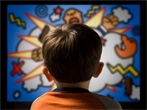Tuesday, 19 January 2016
Device screens: tools of liberation, or enslavement?
 As a parent, I sometimes find my patience sorely tried when my teen is so busy playing with his iPod that I have to call him 50 times for dinner. He’s not impressed when I tell him that what he’s doing with his gadget (usually, pressing some kind of button to score some kind of points) is no different from the laboratory rats who keep frantically pressing a lever because they have learned that that will get them a pellet of food. Such operant conditioning is a powerful mechanism, very well preserved in humans because of its obvious adaptive value, but it can easily hypnotize us if we do not realize its power.
As a parent, I sometimes find my patience sorely tried when my teen is so busy playing with his iPod that I have to call him 50 times for dinner. He’s not impressed when I tell him that what he’s doing with his gadget (usually, pressing some kind of button to score some kind of points) is no different from the laboratory rats who keep frantically pressing a lever because they have learned that that will get them a pellet of food. Such operant conditioning is a powerful mechanism, very well preserved in humans because of its obvious adaptive value, but it can easily hypnotize us if we do not realize its power.
The potential dangers of screen devices were the topic of a symposium held at the University of Quebec at Trois-Rivières in March 2015 (for the agenda, see the first link below). This is a very broad topic, because it encompasses dependencies on television sets, video games, tablet devices, social networks, and so on, as well as the negative values or behaviours that are exacerbated by these screen-based technologies. Compulsive use of pornography is an obvious example; so is the banalization of violence.
For example, the introduction to the symposium agenda states that after having spent an average of over 40 hours per week in front of various screens (that’s over 5 hours per day!), North American children have witnessed 100 000 acts of aggression and 8000 murders before their 13th birthday.
When researchers in Indiana examined the 50 favourite television shows of children ages 2 to 11, they found that these shows get laughs from their viewers by presenting acts of social aggression—an average of 14 per hour, or one every 4 minutes. This finding should be considered together with another study, discussed in an earlier posting in this blog, which showed that the more time children spent in front of the television at ages 2 and 4, the more problems they had in school later on, and the more unhealthy lifestyle patterns they developed, such as obesity and lack of exercise. And more and more studies show that even among people who do move a bit every day, spending long periods of time sitting may offset the healthy effects of a short daily walk (see second link below).
Such findings are highly relevant at a time when we are starting to see new terms such as “nomophobia” to denote the deep anxiety that some teens feel at the mere thought of going to bed without their cell phones, and digital “detox” clinics opening in countries such as the United States, Canada, Japan, China, and South Korea.
All of this makes me think about a rather cruel joke that I saw in a satirical cartoon some time ago: Sebastian, 943 friends on Facebook, ate dinner alone again tonight.”
![]() Les écrans : libération ou esclavage ?
Les écrans : libération ou esclavage ?
![]() It doesn’t matter how much you exercise if you also do this
It doesn’t matter how much you exercise if you also do this
![]() EDUPAX
EDUPAX
Pleasure and Pain | Comments Closed








